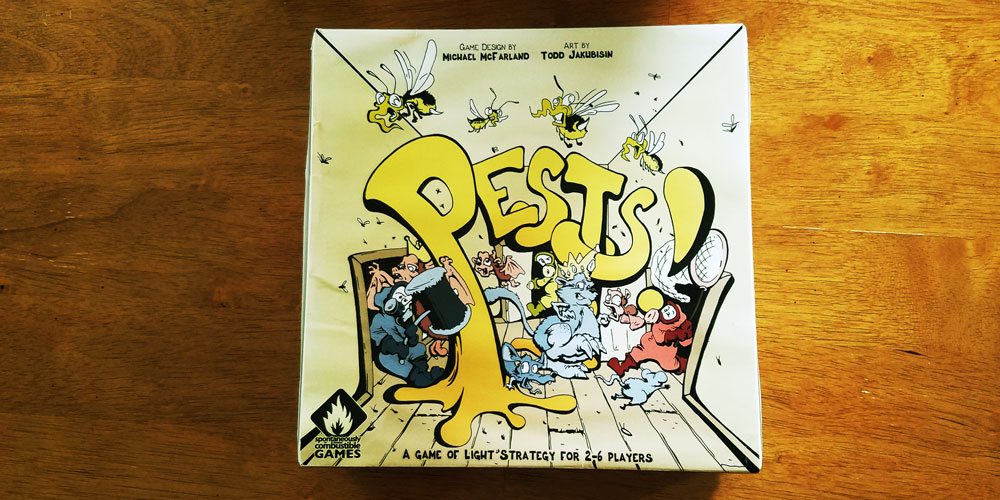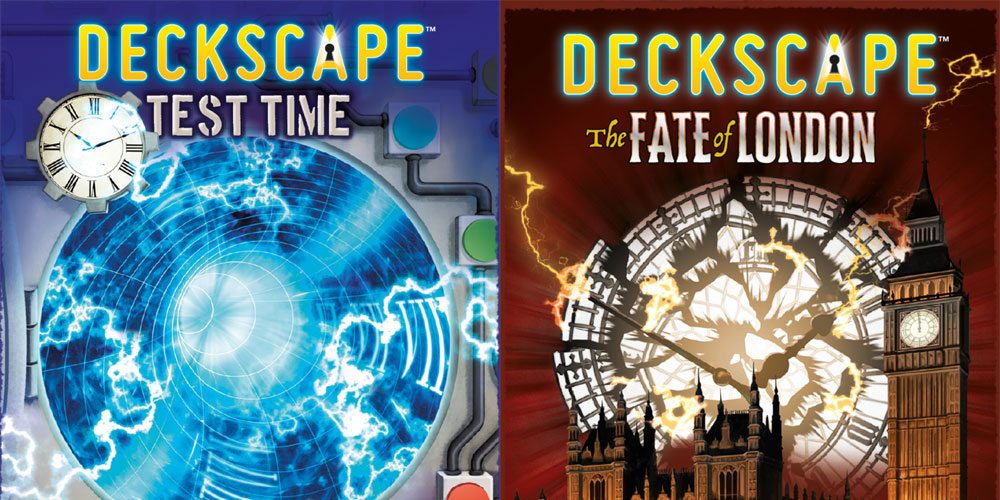
Pests! is a fun new light strategy tabletop game that launched on Kickstarter this week.
At a glance: In Pests!, players take the role of an exterminator who specializes in one particular type of pest. They are among several who have been hired by a homeowner to rid a large house of vermin, but the homeowner is only going to pay the first exterminator to get rid of their particular type of pest.
The game is for 2-6 players. The box says that it’s for ages 14 and up. The prototype I was sent definitely had some small pieces, but I plan to play the game with my 11-year-old when he gets back from visiting his grandparents and I’m not worried that he might not be able to handle the game. A $39 pledge on the Kickstarter campaign will get you a copy of the game.
Disclaimer: I was sent a copy of the game for review purposes.
New to Kickstarter? Check out our crowdfunding primer, and visit our curated page for more projects we love.

Components:
18 square house room tiles
6 square nest tiles
1 oblong entry tile
6 exterminators
144 pests in 6 colors (the prototype had small foam circles, but the Kickstarter page shows that these will be larger cardboard discs)
6 pest queens
28 toolbox cards, split evenly between offensive and defensive cards
7 traps, one in each color plus an additional green trap
6 nest seal tokens
1 standard six-sided die
1 custom six-sided die
The artwork on the pieces was nicely done. All of the artwork matches the somewhat silly theme of the game, and the important stuff, such as the doorways in the rooms and differentiation between the colors of the pieces, is very clear. Note that all pictures here, except the one above, are of pieces from the prototype, so the artwork, colors, and materials used in them are subject to change.
How to play:
You can download a copy of the rules and a print-and-play version of the game from the designer’s Dropbox account.
You can also try out the game on Tabletopia.
The goal of the game is to be the first player to seal the nest for your particular type of pest, trap the queen, and exterminate all of the pests.
Each player chooses an exterminator. Each one has special abilities, so the rules provide for a random selection order, but as with other games like this we always just pick the one we like the best. Then, each player gets to select their starting hand of the toolbox cards. The first few times you play, you’ll likely want to do this by simply dealing them out, but you will discover that some cards are much more useful than others based on how you choose to play, so eventually you’ll want to do as the rules suggest and lay out all of the cards, allowing each player to choose them one at a time. Regardless of how you do that selection, you’ll shuffle the rest and place them in a draw pile.
Then, players build the house. Each player has their appropriately colored nest. The entry room tile is placed in the middle of the table, and the rest of the rooms are dealt randomly to each player. Then, using the same order as was used for the cards and exterminators, each player places a tile to build the house. The only real rules here are that doors have to match up to other doors and you can’t place your nest tile until the third round.

The first time you play, this will need to be semi-random, but you’ll soon discover that a lot of the strategy in the game happens during this tile placement. Because your exterminator needs to get to the nest, and based on how the queen moves, how you build out the house will greatly impact how the game plays out. I’ve played a game a few times now, and I still haven’t quite figured out the ideal strategy for this.
The final setup step is infesting the house. Each player puts their queen in their nest and their exterminator in the entry room. Then, they take seven pests from their reserve. Three of the pests will be placed in the nest, with the other four placed in adjacent rooms. If there aren’t four adjacent rooms–if you placed your nest in the middle of a long hallway or something–then the pests end up dropping in based on what the game refers to as DLUR order. That’s Down, Left, Up, Right, and it’s important throughout the game.
Once the house the built and infested, play can begin. Each player’s turn consists of two phases: the Queen’s Turn and the Exterminator’s Turn. On the Queen’s Turn, the player rolls the custom Queen Die. Four sides of this die have those four aforementioned directions on them (DLUR). If one of those is rolled, the Queen moves in that direction. The rules outline what happens if she can’t–again, there may not be an adjacent room in one or more directions. When she moves into a room, she drops a pest.
The other two sides of the die are S and P. If you roll S, the Queen summons the pests–every pest in the house of that color moves one room towards the Queen. If you roll P, she populates, so instead of dropping one pest in her current room, she drops 4 pests in each of the adjacent rooms.
Finally, one additional pest is added to the nest.

On the Exterminator’s turn, you get one free movement, so long as you take that as your first action. Then, you have two additional action points to spend. Moving further requires 1 point. Exterminating pests in your current room costs one point as well. But, to exterminate, you roll the standard d6 and kill only that number of pests. You can also drop your trap in the room for a point, which will grab either the Queen or up to seven pests. If you already dropped a trap, you can spend a point to empty it, thus killing any pests you caught. (You can’t empty the trap if you have the Queen in it until the end of the game, but it’s possible for the Queen to escape.) You can drag a trap you dropped earlier to another room, regardless of whether or not pests are in it, for two points. Two points can also seal the nest, which is one of the victory conditions. Once sealed, the nest will no longer generate new pests, but other players can come along and unseal your nest at a cost of two points. If you’re in a room with an opponent’s trap, you can spend a point to destroy it, thereby releasing any pests (or the Queen) they might have trapped and returning it to the player. You can also spend a point to play a toolbox card, or two points to draw a new one.
Any of these actions can be repeated, so it’s possible to move into an adjacent room with your free movement, then move into another room with your first action point, then roll to exterminate with your second. However, your free movement has to be the first thing you do, so if you’re in a room with pests, you can spend both points to roll for extermination two times, but then you won’t be able to move.
Gameplay continues around the table until someone wins.

The Verdict
I was pleasantly surprised at how fun the game was. At first glance, it seems like a really light strategy game, but it turns out there’s a lot more strategy than you’d think at first. Right from the start, figuring out how to set up the house requires a lot of thought. Then, determining on each move how to spend your points, and crucially, whether to focus on your own pests or go after other players, gives the game a lot of depth. The first time I played, there were a few occasions where one player seemed to be in an unstoppable position and about to win, but then someone else suddenly played a card that set them way back. And other times, it looked like I was close to winning, but then, dang it, suddenly a bunch of pests pop up because I got a bad roll on the Queen die or another player dropped a card on me, and I went from being one move away from ending the game to many moves away. The game not only nicely balances luck and strategy, it also balances the powers of the various exterminators, making sure no one is too strong at any point.
I would definitely recommend that game, and I will be looking forward to seeing the finished version after the Kickstarter campaign ends.



